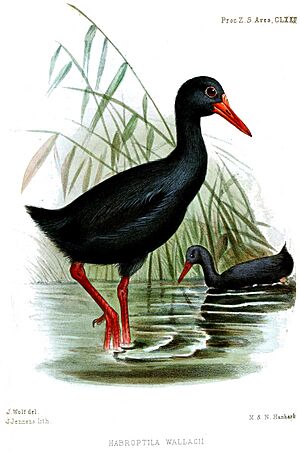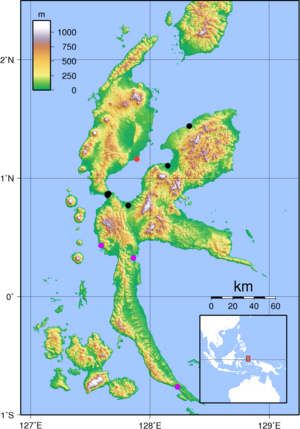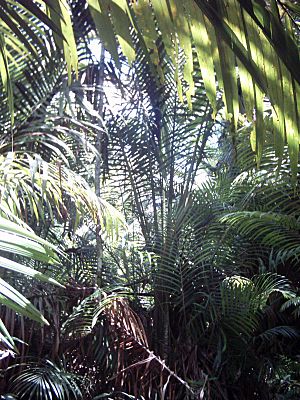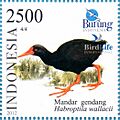Invisible rail facts for kids
Quick facts for kids Invisible rail |
|
|---|---|
 |
|
| Adult by Joseph Wolf, 1859 | |
| Conservation status | |
| Scientific classification | |
| Genus: |
Habroptila
|
| Species: |
wallacii
|
 |
|
|
Recent records
Inset shows location of Halmahera within Indonesiapre-1950 records Kao town |
|
| Synonyms | |
|
Gallirallus wallacii |
|
The invisible rail is a special bird found only on the island of Halmahera in Indonesia. It's also called Wallace's rail or drummer rail. This large bird cannot fly, and it lives in thick sago swamps next to forests.
This rail has dark grey feathers. The skin around its eyes, its long, thick beak, and its legs are all bright red. It makes a low drumming sound, which is why it's called the "drummer rail." It also beats its wings when it calls. It's very shy and hard to spot in its dense home. Because of this, we don't know much about how it behaves.
The invisible rail eats sago shoots and insects. It also swallows small stones to help digest its food. Scientists think these birds stay with one partner for life. The only known nest was a shallow bowl in a rotting tree stump. It was lined with wood chips and dry leaves. The two young chicks found in it were covered in black down, which is typical for baby rails.
There are an estimated 3,500 to 15,000 invisible rails left. Because it lives in a small area and its numbers are not very high, the International Union for Conservation of Nature (IUCN) lists it as a vulnerable animal. Its home is shrinking because people harvest sago and turn swamps into rice fields. Local people also hunt the rail for food.
Contents
About the Invisible Rail
The invisible rail is a large bird, about 33 to 40 centimeters (13 to 16 inches) long. It cannot fly. Adult birds are mostly dark slate-grey. Their lower back, rump, and wings are dark brown. The feathers under their body are a bit lighter grey.
A special feature is the bright red skin around its eyes. Its long, thick beak and strong legs are also bright red. Both male and female birds look the same. Young birds that have left the nest have not had their feathers described yet.
The invisible rail looks a little like the purple swamphen, which is also found in Halmahera. But the swamphen is bigger, has a shorter red beak, and purple feathers. The invisible rail is also different from the Calayan rail because it's larger and doesn't have striped feathers.
The Drumming Call
The invisible rail's call is a low drumming sound. It also makes a "tuk, tuk, tuk" noise with its wings. This unique sound led to a local story that the bird beats on a hollow tree with its feet.
A German bird expert named Gerd Heinrich heard the call in the 1930s. He said it was a quiet drumming sound that sometimes ended in a loud, sharp scream. The bird also makes a dull hum, similar to a banded pig. The rails call most often in the early morning or late evening. If a person taps a sago stem with a machete, the bird might answer. A quieter version of the call is used near the nest.
Where the Invisible Rail Lives
The invisible rail lives in the very dense, spiky sago swamps of Halmahera. It especially likes areas where forests meet these boggy swamps.
It's very hard to see this bird. Gerd Heinrich, the bird expert, wrote about the sago swamps in the 1930s. He said that no European had likely seen this bird alive because its home is so difficult to enter. The rail is protected by the terrible thorns of the sago swamps.
Between 1950 and 2003, most sightings of the rail were in a small part of western Halmahera. But before 1950, it was seen as far south as the island's tip. More recent sightings show it lives in a much larger area, including the northeast of the island. Locals also say it lives in swamps near Kao in the northwest.
Life Cycle and Behavior
Because its home is so difficult to access and the bird is very shy, we don't have much information about its daily life. There have been only a few confirmed sightings.
The invisible rail eats sago shoots and insects. It also feeds at cut sago plants, but it's not clear if it eats the plant itself or looks for other food there. Like all rails, it swallows small stones to help grind its food in its stomach.
Scientists believe the invisible rail is monogamous, meaning it has one partner for life. But we don't know much about how they find partners or prepare for nesting.
In November 2010, a nest was finally found. It was in the top of a rotting tree stump, about 1 meter (3 feet) above the ground. The nest was about 46 meters (150 feet) from the edge of a dry swamp forest. The nest was a shallow dip, about 15 centimeters (6 inches) deep. It had small wood chips at the bottom and was lined with dead leaves.
The eggshells found were brownish-white with dark brown and black spots. The two very young chicks were completely covered in black down feathers. Their beaks were black with a white tip, and their legs were brown with black streaks. Their eyes had grey irises and blue pupils. Baby rails leave the nest very soon after hatching, so these chicks were probably only a day or two old.
Conservation Status
Bird species that live in a small area are very easily affected by human activities. In the Northern Maluku region, eight of the 26 bird species found only there are threatened, including the invisible rail. Almost a quarter of all rail species worldwide are a concern for conservation. Flightless island species are especially at risk, with at least 15 species having disappeared since the 1600s.
The estimated population of the invisible rail is between 3,500 and 15,000 birds. Because it lives in a small area and its numbers are not high, the International Union for Conservation of Nature (IUCN) lists it as a vulnerable species. However, this rail is so hard to find that it might be more common than we think.
Its habitat is being lost because people harvest sago for commercial use. Swamps are also being changed into rice fields and fishponds. Local people value the rail as food. They catch it using traps made from bark strings and hunt it with dogs. The only known nest was in an area often used by local villagers. This suggests the rail might be able to adapt to changes in its habitat better than expected. Also, several sightings in northeast Halmahera in 2008 and 2011 show that the bird is still present in a wider area than previously thought.
Images for kids
-
Adult by Joseph Wolf, 1859








